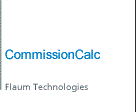
|
 |
||

|
The Best Commission Calculator for You Four Options for Automating Commissions Many accounting functions are similar from company to company. You probably use standard A/R, A/P, and General Ledger software whether you import food or provide training services. Commissions are different. Companies develop unique plans, optimized for their business strategy. In fact, companies frequently have great variety within their plan, computing compensation differently for different products, customers, or sales representatives. Accountants use many different tools to compute these varied commissions. However these tools all fall into four categories:
Fixed-Function Software Standard accounting software usually has the ability to compute simple commission rules, such as: ďAll salespeople get 3% on all sales.Ē Often different rates can be used for different items, customers, etc. For some accounting systems, you can buy software which adds more rules. The defining characteristic of these programs is that they implement certain specific rules. Within the limits of these rules, the user can set predefined parameters. For example, maybe commission is 4%, rather than 3%. However, you cannot add rules. If your commission rate is based on a quota, you can use fixed-function software only if it has a quota feature. Who should use fixed-function commission software? This is usually an easy decision: If the shoe fits, wear it. In other words, if you can find proven fixed-function software which implements your rules, this will probably be the least costly, simplest method of computing your commissions. What if the shoe almost fits? For example, maybe you can find fixed-function software which computes the commission for your salespeople, but not for your sales manager. Or maybe the fixed-function software doesnít support the sales teams you use, but you could assign a salesperson ID to each team and manually distribute commission to team members. There is no general answer to this question. Your choice will depend on your situation: How many hours will you spend making adjustments each month? Will the semi-automatic reports be as accurate and clear as reports created by rule-driven software? What is the cost of each type of software? Occasionally vendors of fixed-function software offer to modify their source code to compute a unique commission plan. They may claim that this makes their product equivalent to rule-driven software. However, this is far from the case; it actually results in a form of custom software. You will need to customize every new version of the commission software — and you will need a new version of the commission software whenever you update your accounting software. Furthermore, since only the software vendor can customize their source code and each customization is unique, they can do this on whatever schedule and at whatever price they consider appropriate. In contrast, version updates to rule-driven software do not require manual rule changes, accounting-system updates typically do not require updates to the commission software, and updates are generally included in moderately-priced annual support contracts. Report Writers Custom reports are a common way to compute unique commission plans. Often, they do this well. In fact, custom commission reports are really a special case of the custom commission software option described below. What distinguishes custom reports from other custom commission software is that they are much less costly to implement. Unfortunately, with this lower cost comes reduced flexibility and power. Specifically, report writers have three limitations.
Rule-Driven Commission Software A rule-driven commission program is one that bases its computations on rules supplied by the user, rather than requiring the user to select from a fixed set of preprogrammed rules. Figure 1: Rule-Driven Commission Software With fixed-function commission software, the data passes directly from your accounting database to the standard computation and reporting software Ė i.e. directly from the green Data layer to the grey Standard Software layer in the diagram above. There is no tan Template layer. Rule-driven commission software, in contrast, inserts a middle, user-defined layer to specify your commission rules. Since this middle layer is configured for each user, virtually any commission computation can be made. The commission software uses both the database and the rules. Therefore, rule-driven software offers much more flexibility than report writers and fixed-function software. Why hasnít rule-driven software entirely replaced fixed-function commission software? Because it has historically been much more costly to buy and implement. In fact, traditional rule-driven commission software was designed only for companies with very large sales forces, because only they could afford it This changed with the introduction of CommissionCalc in 2000. The link at the left above explains how CommissionCalc makes rule-driven software accessible to companies with small and mid-sized sales forces and saves money for companies with many salespeople. Also, you can view a prerecorded, three-minute demonstration of CommissionCalc. Custom Software Custom commission software varies greatly. Today, it is very rarely used to compute commission, except in two extreme cases.
What Is Best for You? In principle, there are many options. In practice, the number of viable options depends on both what your commission rules are and what accounting software you use.
|
||||||||||||
| © Copyright 2000-2009, an unpublished work by Flaum Technologies Inc. | Legal | |||||||||||||

